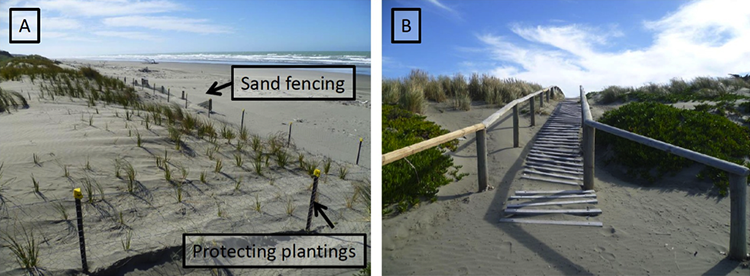Coastal Dune Protection and Restoration
Case Study 4: Dunes in Massachusetts
Sand dunes are common features in coastal zones and desert environments. Along the coast, dunes can protect beaches from erosion during storms and supply sand to a beach that is eroding. Dunes also provide habitat for highly specialized plants and animals, including rare and endangered species. Because of threats by both intentional and unintentional human activity and because of the benefits they offer, such as storm protection and sediment cycling between dune and beach environment, many countries such as the Netherlands, United Kingdom, and the United States employ dune protection programs. These include stabilization programs and restoration efforts centered on building or re-building dunes. Protection, stabilization, and restoration methods utilize measures to reduce the transport of sand by wind and water, such as planting vegetation, constructing sand fences, and selecting access areas that avoid damage to dunes and dune vegetation from foot traffic.
It is important to consider dune structure when planting dune vegetation. Dunes are composed of the foredune (the part that faces the ocean), the sand plain (the dune crest or top), and the backdune (the side facing away from the ocean). The micro-environments of these dune components limit the types of plants that can thrive on them. For instance, foredune plants need to be tolerant to salt spray, strong winds, and some burial by wind-blown sand from the berm and beach environment, while sand plain and backdune plants can be less tolerant of these stresses because they are typically protected from salt spray and sand burial.
Managing coastal dunes for use as part of a flood protection and mitigation strategy involves an integrated management approach or plan, which follows closely with some of the principles we introduced for soft shoreline engineering. These are to:
- restore and preserve natural processes (that is, work with nature);
- create conditions and opportunities for establishing future natural processes (that is, maintain mass and energy flow);
- prevent land use practices that hinder any of the above.
In the Cape Cod area of Massachusetts, erosion caused by winter storms, in particular, results in loss of beach area. And one solution put into practice to address this issue is dune restoration using sand fencing to trap sand and build new dunes. This technique, in concert with planting suitable beach grass species to hold the sand in place, can be a very effective method.
Recommended Resource
The document "Coastal Dune Protection and Restoration" from Woods Hole Sea Grant and Cape Cod Cooperative Extension provides excellent details and illustrations of the process.

